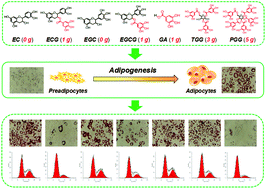The galloyl moiety enhances inhibitory activity of polyphenols against adipogenic differentiation in 3T3-L1 preadipocytes†
Abstract
Previous studies have proved that the characteristic galloyl moiety in polyphenols is crucial for their biological activities. However, whether the presence of the galloyl moiety in the structure of polyphenols has a great contribution to their inhibition of adipogenic differentiation is not clear. Therefore, in this study, seven polyphenols with different galloylation degrees were chosen for exploring the contribution of the galloyl group to the lipid-lowering property of polyphenols and its molecular mechanism. Our results showed that the existence of the galloyl moiety in the structure of polyphenols was necessary for their inhibition of adipogenic differentiation, which could help to delay cells from entering the G2/M phase as well as to hinder the MCE process in the early stage of differentiation and the downstream PPARγ and C/EBPα related MAPK signaling pathway, probably via binding to IR and disturbing the α-helix in its conformation. Our finding highlighted that the existence of galloyl groups in polyphenols was crucial for their anti-adipogenic activity, and provided new insights into the mechanism by which galloylated polyphenols suppress adipocyte differentiation.



 Please wait while we load your content...
Please wait while we load your content...